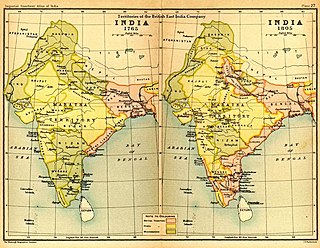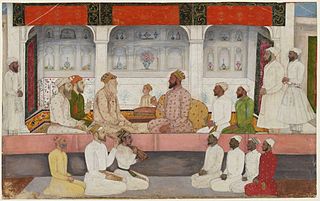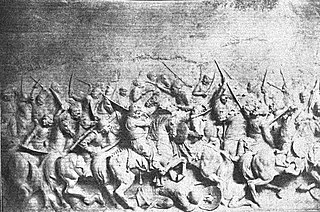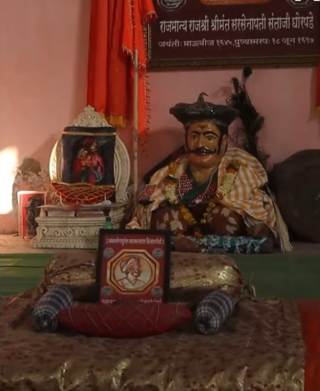
Bajirao I, born as Visaji, was the 7th Peshwa of the Maratha Confederacy.

Narayanrao was the 10th Peshwa of the Maratha Confederacy from November 1772 until his assassination in August 1773. He married Gangabai Sathe who later gave birth to Sawai Madhavrao.

Shahu I was the fifth Chhatrapati of the Maratha Empire founded by his grandfather, Shivaji I. He was born into the Bhonsle family, and was the son of Sambhaji I and Yesubai. At a young age, he was taken into custody at the Siege of Raigad by Mughal emperor Aurangzeb, and held captive by the Mughals. He was released from captivity after the death of Aurangzeb in the hope of engineering an internecine struggle among the Maratha factions of Tarabai and Shahu. Raja Shahu emerged victorious in the bloody Battle of Khed and was crowned as Chhatrapati.

Rajaram Bhonsle I was the third Chhatrapati of Maratha Empire, who ruled from 1689 to his death in 1700. He was the second son of the Shivaji, the founder of the empire and younger half-brother of Sambhaji, who he succeeded. His eleven-year reign was marked with a constant struggle against the Mughals. He was succeeded by his infant son Shivaji II under the regentship of his dowager Maharani Tarabai.

Raghunathrao Bhat, also known as Ragho Ballal or Raghoba Dada, was the younger son of Peshwa Bajirao I who served as the 11th Peshwa of the Maratha Empire for a brief period from 1773 to 1774. He succeeded his Nephew Narayanrao.

The Deccan wars were a series of military conflicts between the Mughal Empire and the descendants of the Maratha ruler Shivaji from the time of Shivaji's death in 1680 until the death of Emperor Aurangzeb in 1707. Shivaji was a central figure in what has been called "the Maratha insurgency" against the Mughal state. Both he and his son, Sambhaji, or Shambuji, typically, alternated between rebellion against the Mughal state and service to the Mughal sovereign in an official capacity. It was common practice in late 17th-century India for members of a ruling family of a small principality to both collaborate with the Mughals and rebel.

The Maratha Conquests were a series of conquests in the Indian subcontinent which led to the building of the Maratha Empire. These conquests were started by Shivaji in 1659, from the victory at the Battle of Pratapgad against Bijapur. The expansion of the empire was limited and interrupted by the Mughal conquests of south India by Mughal ruler Aurangzeb until he eventually died in 1707 in Deccan itself. Marathas were forced to defend their territories against the overwhelmingly strong Mughal army in the 27 years long Deccan wars. They were able to defend their territories and gain an upper hand over Mughals in the sustained conflict.

Battle of Surat, also known as the Sack of Surat, was a land battle that took place on 5 January 1664, near the city of Surat, in present-day Gujarat, India, between Shivaji, leader of the fledgling Maratha Confederacy and Inayat Khan, a Mughal commander. The Marathas defeated the Mughal military unit posted at Surat and ransacked the city.
Santaji Ghorpade (1660–1696) was a Maratha general and held the esteemed position of the 7th Senapati within the Maratha Empire during the reign of Chattrapati Rajaram I. He is widely regarded as one of the foremost experts in Guerrilla warfare. Santaji Ghorpade, in collaboration with Dhanaji Jadhav, conducted a series of successful campaigns against the Mughals from 1689 to 1696. His strategic acumen was demonstrated through the adept utilization of tactics such as guerrilla warfare, ambushes, and swift mobility, ultimately resulting in effective defeats of the Mughal Army. In recognition of his valor, Rajaram bestowed upon him the title of Mamlakat-Madar in 1690.

Ramchandra Neelkanth Bawadekar (1650–1716), also known as Ramchandra Pant Amatya, served on the Council of 8 as the Finance Minister (Amatya) to Emperor (Chhatrapati) Shivaji, dating from 1674 to 1680. He then served as the Imperial Regent to four later emperors, namely Sambhaji, Rajaram, Shivaji II and Sambhaji II. He authored the Adnyapatra, a famous code of civil and military administration, and is renowned as one of the greatest civil administrators, political thinkers, diplomats and military strategists of the Maratha Empire.
Shankaraji Narayan Gandekar (1665–1707), also known as Shankaraji Narayan Sacheev or Shankaraji Narayan, was a popular Minister (Pradhan) and Count (Sardar) of the Maratha Empire. He also served as Imperial Secretary (Sacheev) during Rajaram's reign. He also served as Deputy to the Crown (Rajadnya) under Emperor Sambhaji. His contribution to the war of independence against Mughal rule is considered to be immensely supportive. He was also the founder of the princely state of Bhor located, in Pune district.

The Afghan-Maratha War was fought between the Afghan Empire under Ahmad Shah Durrani and the Maratha Empire and the Sikh Confederacy between 1758 and 1761. It took place in north-west India, primarily the region around Delhi and Punjab.
The Battle of Salher was fought between the Marathas and the Mughal Empire in February 1672 CE. The battle was fought near the fort of Salher in modern day Nashik district. The result was a decisive victory for the Marathas. This battle is considered particularly significant as it is the first pitched battle where the Mughal Empire lost to the Marathas.
Ahmad Shah Durrani raided India for the fifth time in 1759, initiating a series of conflicts with the Marathas and Sikhs. The Pashtuns, preparing for armed struggle, quickly advanced into Punjab, capturing a Maratha garrison at Peshawar and later overrunning Attock. General Jahan Khan played a key role in the advance but was met with resistance from the Marathas and their Sikh allies, led by Sabaji Shinde and the armies of the Sukerchakia and Ahluwalia Misls. In a fierce battle, the combined forces of the Marathas and Sikhs defeated the Afghans, killing 2,000 and wounding Jahan Khan. Despite being outnumbered, Sabaji managed to defend Lahore and inflicted a severe defeat on Jahan Khan, who retreated to Peshawar. This defeat angered Ahmad Shah Durrani and prompted him to take action.
Annaji Datto Sachiv was the Sachiv in the Ashta Pradhan mandal of the Maratha Empire during the rule of Shivaji.
The siege of Basavapatan was a military engagement between the Mughal Army and the Maratha troops led by Santaji Ghorpade, the Marathas were defeated and Basavapatan was relieved.

The Battle of Balapur marked a civil conflict among Mughal leaders, triggered by the uprising of the Sayyid Brothers. This uprising led to a decline in the status of other Mughal leaders.

The Battle of Vani was an important military engagement fought between the Maratha ruler Shivaji and the Mughal Empire in 1670. It took place near the town of Vani in present-day Maharashtra, India. The battle was part of the ongoing conflict between the expanding Maratha Empire and the Mughal forces seeking to assert control over the region.

The Battle of Dodderi lasted three days and featured Maratha forces led by Santaji Ghorpad against the Mughal army, With support from the Nayak of Chitaldurg, Santaji's strategic attacks disrupted the Mughal advance, leading to the death of Mughal commander Qasim Khan. The Mughals retreated to the fort of Dodderi, where they faced starvation and hard conditions due to a tight Maratha blockade. Mughal commander Khanazad Khan surrendered and agreed to pay a ransom of 1 lakh rupees.
Battle of Sindhkhed also known as Siege of Sindhkhed was an Indian battle fought in 1757 between Maratha forces under Vishwasrao against Nizam Ali where Marathas defeated the Nizam Army and Nizam sued for peace.












